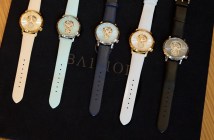We covered this topic earlier in the Tour de France, where Tissot is the official timekeeper. As the Tokyo Olympic Games is currently underway, we thought we’d update the discussion and feature Omega’s technology used to time photo finishes in the 2020 Games.
The technology used at the photo finish is very similar to the one discussed in our article on the Tissot timing of the Tour de France 2017. We recommend you read it as a background.
Tech Bite: How Tissot determines the winner at a Photo Finish
TGIFriday at the Olympic Games: How Omega does the high precision photo finishes
Men’s Road Race, Olympic Games 2020
An example of why the photo finish equipment is essential to determine who won this bike throw at the end of the Men’s Road Race at the 2020 Olympic Games. This photograph was taken with a conventional camera, and it is not possible to determine that Wout van Aert, the rider on the right of the frame riding for Belgium crossed the line first, ahead of Tadej Pogačar of Slovenia. However, with the Omega Photo Finish equipment, it is easy to determine that Wout edged out Tadej by a fraction of a second. The race was won by Ecuador’s Richard Carapas who was crossed the line some 1.07minutes earlier.

However, via the Photo Finish camera, the following image is seen.

With this timing device, it is clearly seen that Wout is slightly ahead of Tadej, even though the official timing for both are the same, completing the tough 234-kilometre course in 6 hours, 6.33 minutes.
The Omega Scan’O’Vision Photo Star Series Finish Camera
In essence, the camera is placed at the finish line, and aligned to look down the line. The camera used for the Olympic Games is the Omega Scan’O’Vision Myria.

This is a special camera which records an image which is 1 pixel wide, but 2048 pixels high. It has no shutter, but the aperture is a thin vertical slit which only 1 pixel wide. This slit is lined up to the finish line, and Omega supplies the other equipment to precisely do this.
As the camera has no shutter, it does not miss anything. The camera is capable of an acquisition speed of 10,000 frames a second, each 1 pixel wide. The Omega system then compiles all the images taken into a single image which we see above, which shows the timeline of the athletes passing that slit over a period of time.

As you compare the first photograph which is taken by a normal camera, you can see the background with “Olympics 2020” in the barriers behind the riders. But in the photo finish image, this background is the single sliver.
The entire photo finish picture is the finish line, stretched out in time, and we are looking at the moment they crossed that 1 pixel wide line. The red lines across the front wheels are computer generated to allow the judges to compare who passed the line first.

Due to the way the photograph is taken, the photo finish image shows various artifacts. The objects moving faster than the refresh rate would look squashed, and those slower would look stretched out. From the photo finish image on the Road Race above, it would appear that Tadej is actually moving faster than Wout while crossing the line, but it is clear that the Belgian crossed the line first. The spokes on the wheels also appear curved, as the outer edge of the wheel is traveling faster than the inner edge.
Winning bikes at the Olympics
While the riders are representing their countries, all three medalists are professional cyclists, who are riding for their trade teams outside of the Games. Indeed all three were riding for their teams at the Tour de France, which concluded just the week before the Olympics Road Race.
The Tour de France is a grueling 21 stage race, done over 23 days. This year, Tadej Pogačar was the rider with the least amount of time (82hr, 56min, 36sec over the 3,414.1km race, and thus the winner of the 2021 Tour de France General Classification. Incidentally, he also took won in the Mountains Classifications and Young Rider Classifications (he was 22 years old). He also won the Tour in 2020. Tadej’s trade team is the UAE Emirates team, who have Richard Mille as one of their sponsors. Tadej has been spotted wearing the RM67-02 during the 2021 Tour, but he won the 2020 Tour in a Breitling sponsored Endurance Pro on his wrist. A recent Instagram image of him at the Tokyo Olympic Games training session saw him with a red Endurance Pro. Tadej was riding his team issue Colnago V3Rs to take Bronze at the Tokyo 2020 Road Race.
Wout van Aert also participated at the Tour de France 2021, and won several stages, but finished outside of the Top 10 in the General Classification. In the Olympics, he too was riding his trade team, Jumbo Visma’s team issue of the Cervelo S5 bike to win the Silver in Tokyo.

And finally Richard “Billy” Carapas was also at the 2021 Tour de France, coming in third overall in the General Classification, 7min 3sec behind Tadej. In Tokyo, Billy was riding his Team Ineos Grenediers issue Pinarello Dogma F to Gold victory. This is the latest iteration of the Pinarello Dogma F10 we have featured here.





2 Comments
Excelente artículo. Muy esclarecedor e interesante.
Muchísimas gracias!